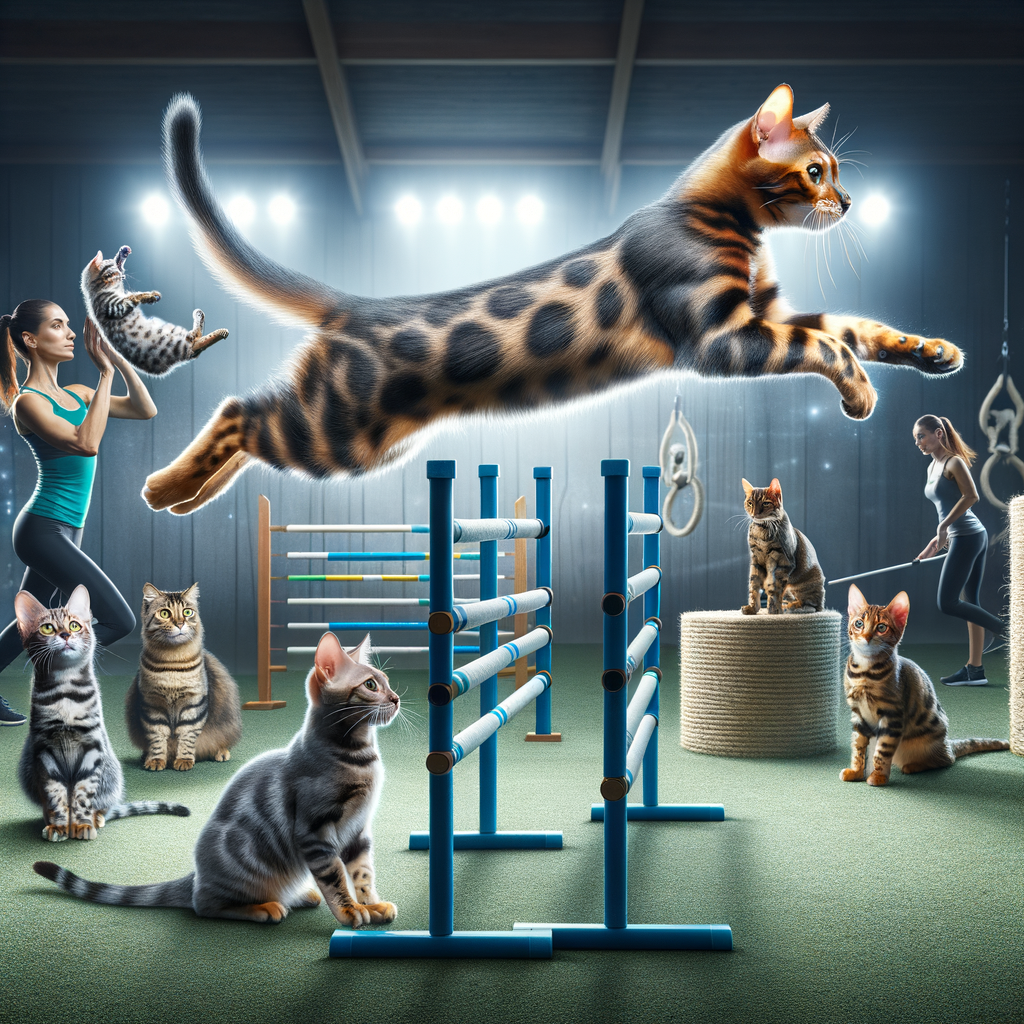
Introduction to Bengal Cat Training
Welcome to the fascinating world of Bengal cat training. This guide is designed to provide you with all the necessary information to understand and train your Bengal cat effectively. Let’s dive in!Bengal cats are not your ordinary house cats. They are a breed that combines the exotic charm of wild cats with the friendly nature of domestic ones. Known for their strikingly beautiful coat that resembles a leopard’s, Bengal cats are highly active, intelligent, and playful. They possess a strong hunting instinct and love to explore their surroundings.
One of the most distinctive traits of Bengal cats is their high energy level. They are always on the move and require plenty of mental and physical stimulation to keep them happy and healthy. This is where training comes into play. Training not only helps channel their energy in a positive direction but also strengthens the bond between you and your Bengal cat.
Agility training is a fantastic way to keep your Bengal cat physically active and mentally stimulated. It involves teaching your cat to navigate through a course of various obstacles such as tunnels, jumps, and weave poles. Agility training can be a fun and rewarding experience for both you and your Bengal cat.
Research has shown that agility training can help improve a cat’s confidence, reduce behavior problems, and promote overall health. It can also help strengthen the bond between you and your cat as it requires teamwork and communication. Remember, the goal of agility training is not just to have a well-trained cat, but to have fun and build a stronger relationship with your feline friend.
In the following sections, we will delve deeper into the world of Bengal cat training, covering everything from beginner techniques to advanced strategies. Whether you’re a novice or an expert, this guide has something for everyone. So, let’s get started on this exciting journey!
Beginner Cat Training: Getting Started
Training your Bengal cat can be a rewarding experience for both you and your feline friend. It’s important to understand your Bengal cat’s behavior to ensure a successful training session. Let’s delve into some key aspects of Bengal cat behavior.
Understanding Your Bengal Cat’s Behavior
Before we start training, it’s crucial to understand your Bengal cat’s behavior. This involves recognizing signs of stress or discomfort and interpreting your cat’s body language.
-
- Recognizing signs of stress or discomfort
Just like humans, cats also experience stress and discomfort. Signs of stress in cats include excessive grooming, loss of appetite, and changes in behavior. For instance, a normally playful cat might become withdrawn. If you notice these signs, it’s important to address them before proceeding with training.
-
- Interpreting your Bengal cat’s body language
Understanding your Bengal cat’s body language is key to successful training. A relaxed cat will have its tail up, ears forward, and eyes half-closed. On the other hand, a scared or aggressive cat will have its tail puffed up, ears flat against the head, and eyes wide open. By interpreting these signs, you can adjust your training approach accordingly.
Remember, every cat is unique and may show different signs of stress or use different body language. The key is to spend time with your Bengal cat and get to know its individual behaviors and quirks.
Understanding your Bengal cat’s behavior is the first step in successful training. In the next section, we’ll talk about setting up your training space.
Setting Up Your Training Space
Creating the perfect training space for your Bengal cat is a crucial step in the training process. This space should be comfortable for your cat and conducive to learning. Let’s discuss how to choose the right location and the essential equipment you’ll need.
- Choosing the Right Location
The location of your training space plays a significant role in your cat’s learning process. It should be a quiet, distraction-free area where your cat feels safe and comfortable. Avoid high-traffic areas in your home, like the living room or kitchen, as these can be too distracting for your cat.
Consider using a spare room or a quiet corner of your home. The space should be large enough for your cat to move around freely but small enough to keep them focused on the task at hand. Remember, consistency is key. Once you’ve chosen a location, try to stick with it for all training sessions.
- Essential Equipment for Beginner Cat Training
Once you’ve chosen the perfect location, it’s time to gather your training equipment. Here are some essential items for beginner cat training:
- Clicker: This small device makes a clicking sound that you can use to mark the exact moment your cat performs a desired behavior. It’s a powerful tool for positive reinforcement training.
- Treats: Treats are a great way to reward your cat for good behavior. Choose small, low-calorie treats that your cat loves.
- Toys: Toys can be used as a reward or to encourage certain behaviors. For example, a feather wand can be used to teach your cat to jump or climb.
- Scratching Post: A scratching post is essential for any cat training space. It gives your cat a place to scratch and stretch, which can help reduce unwanted behaviors like scratching furniture.
Remember, the goal of setting up your training space is to create a positive, stress-free environment where your Bengal cat can learn and grow. Happy training!
Bengal Cat Agility: Basic Techniques
Training a Bengal cat to be agile is not only fun but also beneficial for the cat’s health and well-being. In this section, we will focus on one of the basic techniques: training your Bengal cat to jump.
Training Bengal Cats to Jump
Jumping is a natural activity for cats, and with a little training, your Bengal cat can learn to jump on command. Here are the steps to follow:
-
- Introducing the Jump Command
The first step in training your Bengal cat to jump is introducing the jump command. Start by choosing a specific word or phrase, like “jump” or “up”, and use it consistently each time you want your cat to jump. Use a treat or a toy to lure your cat into a jumping position, and say the command as they jump. Reward them immediately after they jump to reinforce the behavior.
-
- Progressing from Low to High Jumps
Once your Bengal cat has mastered the jump command, you can start to increase the height of the jumps. Start with low objects and gradually move to higher ones. Always ensure the landing area is safe and soft to prevent injuries. Remember to be patient and consistent in your training, and always reward your cat for their efforts.
Training your Bengal cat to jump not only enhances their agility but also provides them with physical exercise and mental stimulation. It’s a fun and rewarding activity that you and your cat can enjoy together.
Training Bengal Cats to Navigate Tunnels
Training your Bengal cat to navigate tunnels can be a fun and rewarding experience. This agility exercise not only provides physical stimulation but also mental engagement for your feline friend. Let’s break down this process into two simple steps.
-
- Introducing the Tunnel Command
Start by introducing the tunnel to your Bengal cat in a calm and comfortable environment. Place the tunnel on the floor and let your cat explore it at their own pace. Use a clear and consistent command, such as “tunnel,” each time your cat approaches the tunnel. This will help them associate the command with the action.
-
- Encouraging Your Bengal Cat to Enter and Exit the Tunnel
Once your cat is comfortable with the tunnel and the command, it’s time to encourage them to enter and exit the tunnel. You can do this by using treats or their favorite toy. Place the treat or toy at the end of the tunnel and use the tunnel command. Praise your cat when they successfully navigate through the tunnel. Repeat this process until your cat can enter and exit the tunnel on command.
Remember, patience is key when training your Bengal cat. It may take some time for them to understand and follow the command. But with consistent training and positive reinforcement, your Bengal cat will soon be navigating tunnels like a pro.
| Training Steps | Key Points |
|---|---|
| Introducing the Tunnel Command | Use a clear and consistent command, let your cat explore at their own pace. |
| Encouraging Your Cat to Enter and Exit the Tunnel | Use treats or toys, praise your cat for successful navigation, repeat the process. |
In conclusion, training your Bengal cat to navigate tunnels can be a fun and enriching activity for both you and your feline friend. It not only enhances their agility but also strengthens the bond between you and your cat. Happy training!
Pro Cat Training: Advanced Techniques
As you continue to train your Bengal cat, you will find that there are more advanced techniques that can be used to further enhance their agility and intelligence. One such advanced technique is weaving. Weaving is a great way to challenge your cat’s agility and mental prowess.
Professional Bengal Cat Training for Weaving
Weaving involves your cat moving in and out of a series of poles, much like a slalom skier. It’s a fun and engaging activity that can be taught to your Bengal cat with a little patience and persistence. Here are some steps to get you started:
-
- Introducing the weave command: Start by setting up a few poles in a straight line. Use a treat or toy to lure your cat through the poles, using the command “weave”. It’s important to be consistent with your command and reward your cat immediately after they successfully weave through the poles. This will help them associate the command with the action.
- Increasing the number of weave poles: Once your cat has mastered weaving through a few poles, you can start to increase the number of poles. Add one pole at a time and practice the weave command until your cat is comfortable with the new setup. Remember to always reward your cat for their efforts to encourage them to continue trying.
Training your Bengal cat to weave can be a fun and rewarding experience for both of you. It not only helps to improve their agility but also strengthens the bond between you and your cat. Remember, patience and consistency are key in any training regimen.
Professional Bengal Cat Training for Climbing
Training your Bengal cat to climb can be a rewarding experience. Not only does it provide your feline friend with a fun and engaging activity, but it also helps to keep them fit and agile. Here, we will cover two key steps in the process: introducing the climb command and progressing from low to high climbs.
- Introducing the Climb Command
Before you can start training your Bengal cat to climb, you need to introduce the climb command. This command will be the signal for your cat to start climbing. It’s best to choose a simple, one-word command, such as “up”.
Start by standing near a low climbing structure, like a cat tree or a sturdy shelf. Hold a treat above the structure and say your climb command. When your cat climbs up to get the treat, give them lots of praise. Repeat this process several times until your cat starts to associate the command with the action of climbing.
- Progressing from Low to High Climbs
Once your cat is comfortable with the climb command and can easily climb low structures, it’s time to progress to higher climbs. This should be done gradually to ensure your cat’s safety and comfort.
Start by gradually increasing the height of the climbing structure. Each time your cat successfully climbs the structure, give them a treat and lots of praise. If your cat seems hesitant or scared, lower the height and try again.
Remember, patience is key when training your Bengal cat to climb. It may take some time for your cat to feel comfortable with high climbs, and that’s okay. The most important thing is that your cat is having fun and getting exercise.
In conclusion, training your Bengal cat to climb involves introducing the climb command and gradually increasing the height of the climbs. With patience and consistency, your cat will soon be scaling heights like a pro!
Bengal Cat Agility Courses: What to Expect
When it comes to Bengal cat agility courses, there are a few key things to expect. These courses are designed to challenge your cat’s physical and mental abilities, providing them with a fun and engaging way to exercise. Let’s delve into what you can anticipate from a typical Bengal cat agility course and how to prepare your feline friend for the challenge.
-
- Typical Obstacles in a Bengal Cat Agility Course
Agility courses for Bengal cats often include a variety of obstacles designed to test their speed, agility, and problem-solving skills. Here are some of the most common ones:
-
-
- Tunnels: These are long, cylindrical structures that your cat must run through. They test your cat’s willingness to enter confined spaces.
- Jumping Hoops: These are circular hoops that your cat must jump through. They test your cat’s jumping ability and precision.
- Weaving Poles: These are a series of vertical poles that your cat must weave in and out of. They test your cat’s agility and coordination.
- Preparing Your Bengal Cat for an Agility Course
-
Preparing your Bengal cat for an agility course requires patience, consistency, and positive reinforcement. Here are some steps to get you started:
-
- Start with Basic Training: Before introducing your cat to the agility course, make sure they have a good grasp of basic commands like “sit”, “stay”, and “come”.
- Introduce the Obstacles Gradually: Start by introducing one obstacle at a time. Allow your cat to explore and get comfortable with each obstacle before moving on to the next one.
- Use Positive Reinforcement: Always reward your cat with treats and praise when they successfully complete an obstacle. This will motivate them to continue trying and improve their performance.
Remember, every cat is unique and will progress at their own pace. The most important thing is to ensure that the experience is enjoyable for your Bengal cat. With patience and consistent training, your feline friend will be navigating the agility course with ease in no time!
Conclusion: The Journey from Novice to Expert
As we wrap up our discussion on Bengal cat training, it’s essential to take a moment to reflect on the journey you and your feline friend have embarked upon. From a novice, you have grown into an expert, capable of guiding your Bengal cat through agility courses with ease and confidence. Let’s take a moment to reflect on this journey and look forward to what lies ahead.
-
- Reflecting on the progress made
Think back to when you first started this training journey. Your Bengal cat was probably unsure, maybe even a little scared. But look at them now! They’re leaping over obstacles, darting through tunnels, and showing off their agility with pride. This progress didn’t happen overnight. It’s the result of your patience, dedication, and the bond you’ve built with your Bengal cat.
-
- Continuing your Bengal cat’s agility training journey
Even though you’ve made significant progress, remember that learning is a continuous journey. There’s always room for improvement and new techniques to explore. Keep challenging your Bengal cat with new agility courses and techniques. Remember, the goal isn’t just to have an agile cat, but to strengthen your bond and ensure your Bengal cat is healthy, happy, and mentally stimulated.
In conclusion, training your Bengal cat isn’t just about teaching them tricks or getting them to follow commands. It’s about understanding their unique needs, building a bond based on trust, and ensuring they lead a healthy, active lifestyle. As you continue this journey, remember to celebrate every milestone, no matter how small. After all, every step forward is a step towards becoming an expert Bengal cat trainer.














